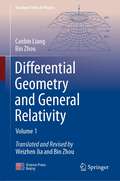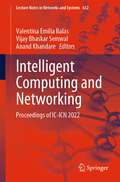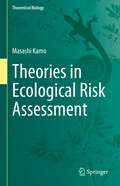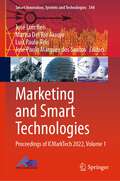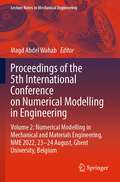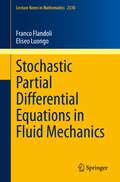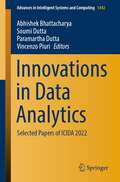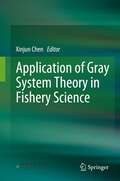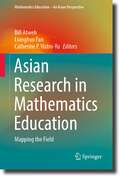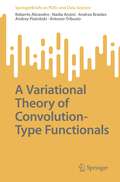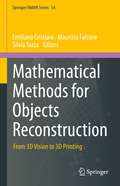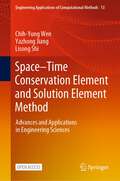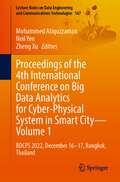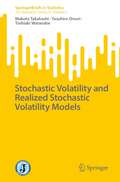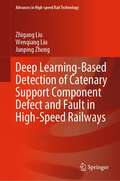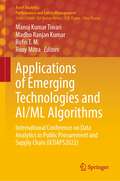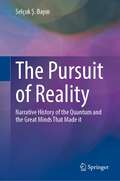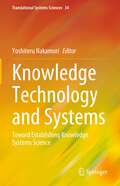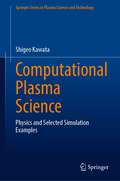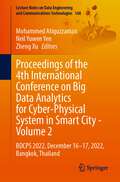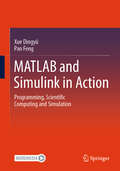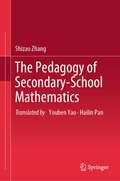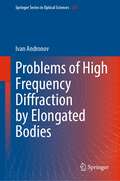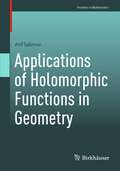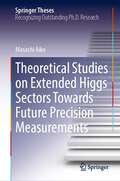- Table View
- List View
Differential Geometry and General Relativity: Volume 1 (Graduate Texts in Physics)
by Canbin Liang Bin ZhouThis book, the first in a three-volume set, explains general relativity using the mathematical tool of differential geometry. The book consists of ten chapters, the first five of which introduce differential geometry, which is widely applicable even outside the field of relativity. Chapter 6 analyzes special relativity using geometric language. In turn, the last four chapters introduce readers to the fundamentals of general relativity. Intended for beginners, this volume includes numerous exercises and worked-out example in each chapter to facilitate the learning experience. Chiefly written for graduate-level courses, the book’s content will also benefit upper-level undergraduate students, and can be used as a reference guide for practicing theoretical physicists.
Intelligent Computing and Networking: Proceedings of IC-ICN 2022 (Lecture Notes in Networks and Systems #632)
by Valentina Emilia Balas Vijay Bhaskar Semwal Anand KhandareThis book gathers high-quality peer-reviewed research papers presented at the International Conference on Intelligent Computing and Networking (IC-ICN 2022), organized by the Computer Department, Thakur College of Engineering and Technology, in Mumbai, Maharashtra, India, on February 25–26, 2022. The book includes innovative and novel papers in the areas of intelligent computing, artificial intelligence, machine learning, deep learning, fuzzy logic, natural language processing, human–machine interaction, big data mining, data science and mining, applications of intelligent systems in healthcare, finance, agriculture and manufacturing, high-performance computing, computer networking, sensor and wireless networks, Internet of Things (IoT), software-defined networks, cryptography, mobile computing, digital forensics and blockchain technology.
Theories in Ecological Risk Assessment (Theoretical Biology)
by Masashi KamoThis book introduces various mathematical models used in ecological risk assessment, primarily discussing models used in hazard assessment. The book aims to link ecology and conservation biology with risk assessments, bringing together the knowledge of ecotoxicology and ecology for effective risk assessment. The first part describes population-level assessment in ecological risk assessment. The chapters cover current methodologies for ecological risk assessment, individual-level assessment, population dynamics models for population-level assessment, case studies, mathematical models for population extinctions, the derivation of mean time to extinction (MTE) and their case studies. The second part of the book discusses the mathematical models involved in hazard assessments. It introduces the method of risk assessment using species sensitivity distributions (SSDs), hazard assessment of metals, chemical mixtures using the Michaelis-Menten equation, basic elements of statistics and related topics. Expected readers are risk assessors in governments and public sectors, students and young researchers interested in environmental science. The book is made accessible and easy to follow by beginners in mathematical biology and theoretical ecology.
Marketing and Smart Technologies: Proceedings of ICMarkTech 2022, Volume 1 (Smart Innovation, Systems and Technologies #344)
by José Luís Reis Marisa Del Rio Araujo Luís Paulo Reis José Paulo Marques dos SantosThis book includes selected papers presented at the International Conference on Marketing and Technologies (ICMarkTech 2022), held at Universidade de Santiago de Compostela, Spain, during 1 – 3 December 2022. It covers up-to-date cutting-edge research on artificial intelligence applied in marketing, virtual and augmented reality in marketing, business intelligence databases and marketing, data mining and big data, marketing data science, web marketing, e-commerce and v-commerce, social media and networking, geomarketing and IoT, marketing automation and inbound marketing, machine learning applied to marketing, customer data management and CRM, and neuromarketing technologies.
Proceedings of the 5th International Conference on Numerical Modelling in Engineering: Volume 2: Numerical Modelling in Mechanical and Materials Engineering, NME 2022, 23–24 August, Ghent University, Belgium (Lecture Notes in Mechanical Engineering)
by Magd Abdel WahabThis book gathers outstanding papers on numerical modeling in Mechanical Engineering (Volume 2) as part of the 2-volume proceedings of the 5th International Conference on Numerical Modeling in Engineering (NME 2021), which was held in Ghent, Belgium, on August 23–24, 2022. The overall objective of the conference was to bring together international scientists and engineers in academia and industry from fields related to advanced numerical techniques, such as the finite element method (FEM), boundary element method (BEM), isogeometric analysis (IGA), and their applications to a wide range of engineering disciplines. This book addresses numerical simulations of various mechanical and materials engineering industrial applications such as aerospace applications, acoustic analysis, bio-mechanical applications, contact problems and wear, heat transfer analysis, vibration and dynamics, transient analysis, nonlinear analysis, composite materials, polymers, metal alloys, fracture mechanics, fatigue of materials, creep, mechanical behavior, micro-structure, phase transformation, and crystal plasticity. The book is intended for academics, including graduate students and researchers, as well as industrial practitioners working in the numerical modeling in mechanical engineering topics.
Stochastic Partial Differential Equations in Fluid Mechanics (Lecture Notes in Mathematics #2328)
by Franco Flandoli Eliseo LuongoThis book is devoted to stochastic Navier–Stokes equations and more generally to stochasticity in fluid mechanics. The two opening chapters describe basic material about the existence and uniqueness of solutions: first in the case of additive noise treated pathwise and then in the case of state-dependent noise. The main mathematical techniques of these two chapters are known and given in detail for using the book as a reference for advanced courses. By contrast, the third and fourth chapters describe new material that has been developed in very recent years or in works now in preparation. The new material deals with transport-type noise, its origin, and its consequences on dissipation and well-posedness properties. Finally, the last chapter is devoted to the physical intuition behind the stochastic modeling presented in the book, giving great attention to the question of the origin of noise in connection with small-scale turbulence, its mathematical form, and its consequences on large-scale properties of a fluid.
Innovations in Data Analytics: Selected Papers of ICIDA 2022 (Advances in Intelligent Systems and Computing #1442)
by Abhishek Bhattacharya Soumi Dutta Paramartha Dutta Vincenzo PiuriThis book features research papers presented at the 1st International Conference on Innovations in Data Analytics (ICIDA 2022), held at Eminent College of Management and Technology (ECMT), West Bengal, India, during November 29–30, 2022. The book presents original research work in the areas of computational intelligence, advance computing, network security and telecommunication, data science and data analytics, and pattern recognition. The book is beneficial for readers from both academia and industry.
Application of Gray System Theory in Fishery Science
by Xinjun ChenThis book reviews the gray system and combines its latest research results in fishery science. The chapters cover the basic concept and theory of gray system, original data processing and gray sequence generation, gray correlation analysis, gray cluster analysis, gray system modeling, gray prediction, gray decision-making, and gray linear programming. The theory of gray system is a new cross-sectional discipline founded in 1982 by Professor Deng Julong, a well-known scholar in China. In recent decades, it has not only been deepened and expanded in theory but also widely used in the fields of society, economy, ocean, agriculture, fishery, and other fields, and made a series of significant scientific achievements. These have laid the foundation for the important position of the gray system theory. Due to the great uncertainty of the fishery resources and the fishery environment involved in the fishery science system, which is completely different from the natural resources on the land, the data and information belong to the category of “poor information”, and the variability and uncertainty are greater than other natural resources. As an extremely effective analytical method and tool, gray system theory has been applied increasingly in fishery science. The book is developed based on well-read and practical literature and will help scientists and research units engaged in scientific research and teaching in fishery science and related fields to develop new research methods and tools.
Asian Research in Mathematics Education: Mapping the Field (Mathematics Education – An Asian Perspective)
by Bill Atweh Lianghuo Fan Catherine P. Vistro-YuThis book focuses on the development of research in mathematics education cultures and its products from the perspective of local educators. It consists of contributions from Mainland China, Indonesia, Korea, Macao, Singapore, the Philippines, and Turkey. This book examines the development of the culture of research in the respective countries and also reviews the research conducted in the recent past in mathematics education. It takes a critical stance through identifying the various accomplishments, and identifying challenges for the future of research in terms of its diversification and quality. Divided into two sections, the first section considers factors around the development of a research culture in the respective countries by focusing on the means used to develop research expertise and quality. The second section consists of overviews of the area of research and methodologies conducted in mathematics education in the various countries, with the intention of highlighting the research topics conducted as well as discussing omissions of such research.
A Variational Theory of Convolution-Type Functionals (SpringerBriefs on PDEs and Data Science)
by Roberto Alicandro Nadia Ansini Andrea Braides Andrey Piatnitski Antonio TribuzioThis book provides a general treatment of a class of functionals modelled on convolution energies with kernel having finite p-moments. A general asymptotic analysis of such non-local functionals is performed, via Gamma-convergence, in order to show that the limit may be a local functional representable as an integral. Energies of this form are encountered in many different contexts and the interest in building up a general theory is also motivated by the multiple interests in applications (e.g. peridynamics theory, population dynamics phenomena and data science). The results obtained are applied to periodic and stochastic homogenization, perforated domains, gradient flows, and point-clouds models. This book is mainly intended for mathematical analysts and applied mathematicians who are also interested in exploring further applications of the theory to pass from a non-local to a local description, both in static problems and in dynamic problems.
Mathematical Methods for Objects Reconstruction: From 3D Vision to 3D Printing (Springer INdAM Series #54)
by Emiliano Cristiani Maurizio Falcone Silvia TozzaThe volume collects several contributions to the INDAM workshop Mathematical Methods for Objects Reconstruction: from 3D Vision to 3D Printing held in Rome, February, 2021. The goal of the workshop was to discuss new methods and conceptual structures for managing these challenging problems. The chapters reflect this goal and the authors are academic researchers and some experts from industry working in the areas of 3D modeling, computer vision, 3D printing and/or developing new mathematical methods for these problems. The contributions present methodologies and challenges raised by the emergence of large-scale 3D reconstruction applications and low-cost 3D printers. The volume collects complementary knowledges from different areas of mathematics, computer science and engineering on research topics related to 3D printing, which are, so far, widely unexplored. Young researchers and future scientific leaders in the field of 3D data acquisition, 3D scene reconstruction, and 3D printing software development will find an excellent introduction to these problems and to the mathematical techniques necessary to solve them.
Space–Time Conservation Element and Solution Element Method: Advances and Applications in Engineering Sciences (Engineering Applications of Computational Methods #13)
by Chih-Yung Wen Yazhong Jiang Lisong ShiThis open access book introduces the fundamentals of the space–time conservation element and solution element (CESE) method, which is a novel numerical approach for solving equations of physical conservation laws. It highlights the recent progress to establish various improved CESE schemes and its engineering applications. With attractive accuracy, efficiency, and robustness, the CESE method is particularly suitable for solving time-dependent nonlinear hyperbolic systems involving dynamical evolutions of waves and discontinuities. Therefore, it has been applied to a wide spectrum of problems, e.g., aerodynamics, aeroacoustics, magnetohydrodynamics, multi-material flows, and detonations. This book contains algorithm analysis, numerical examples, as well as demonstration codes. This book is intended for graduate students and researchers who are interested in the fields such as computational fluid dynamics (CFD), mechanical engineering, and numerical computation.
Proceedings of the 4th International Conference on Big Data Analytics for Cyber-Physical System in Smart City - Volume 1: BDCPS 2022, December 16-17, Bangkok, Thailand (Lecture Notes on Data Engineering and Communications Technologies #167)
by Mohammed Atiquzzaman Neil Yen Zheng XuThis book gathers a selection of peer-reviewed papers presented at the 4th Big Data Analytics for Cyber-Physical System in Smart City (BDCPS 2022) conference, held in Bangkok, Thailand, on December 16–17. The contributions, prepared by an international team of scientists and engineers, cover the latest advances and challenges made in the field of big data analytics methods and approaches for the data-driven co-design of communication, computing, and control for smart cities. Given its scope, it offers a valuable resource for all researchers and professionals interested in big data, smart cities, and cyber-physical systems.
Stochastic Volatility and Realized Stochastic Volatility Models (SpringerBriefs in Statistics)
by Makoto Takahashi Yasuhiro Omori Toshiaki WatanabeThis treatise delves into the latest advancements in stochastic volatility models, highlighting the utilization of Markov chain Monte Carlo simulations for estimating model parameters and forecasting the volatility and quantiles of financial asset returns. The modeling of financial time series volatility constitutes a crucial aspect of finance, as it plays a vital role in predicting return distributions and managing risks. Among the various econometric models available, the stochastic volatility model has been a popular choice, particularly in comparison to other models, such as GARCH models, as it has demonstrated superior performance in previous empirical studies in terms of fit, forecasting volatility, and evaluating tail risk measures such as Value-at-Risk and Expected Shortfall. The book also explores an extension of the basic stochastic volatility model, incorporating a skewed return error distribution and a realized volatility measurement equation. The concept of realized volatility, a newly established estimator of volatility using intraday returns data, is introduced, and a comprehensive description of the resulting realized stochastic volatility model is provided. The text contains a thorough explanation of several efficient sampling algorithms for latent log volatilities, as well as an illustration of parameter estimation and volatility prediction through empirical studies utilizing various asset return data, including the yen/US dollar exchange rate, the Dow Jones Industrial Average, and the Nikkei 225 stock index. This publication is highly recommended for readers with an interest in the latest developments in stochastic volatility models and realized stochastic volatility models, particularly in regards to financial risk management.
Deep Learning-Based Detection of Catenary Support Component Defect and Fault in High-Speed Railways (Advances in High-speed Rail Technology)
by Zhigang Liu Wenqiang Liu Junping ZhongThis book focuses on the deep learning technologies and their applications in the catenary detection of high-speed railways. As the only source of power for high-speed trains, the catenary's service performance directly affects the safe operation of high-speed railways. This book systematically shows the latest research results of catenary detection in high-speed railways, especially the detection of catenary support component defect and fault. Some methods or algorithms have been adopted in practical engineering. These methods or algorithms provide important references and help the researcher, scholar, and engineer on pantograph and catenary technology in high-speed railways. Unlike traditional detection methods of catenary support component based on image processing, some advanced methods in the deep learning field, including convolutional neural network, reinforcement learning, generative adversarial network, etc., are adopted and improved in this book. The main contents include the overview of catenary detection of electrified railways, the introduction of some advance of deep learning theories, catenary support components and their characteristics in high-speed railways, the image reprocessing of catenary support components, the positioning of catenary support components, the detection of defect and fault, the detection based on 3D point cloud, etc.
Applications of Emerging Technologies and AI/ML Algorithms: International Conference on Data Analytics in Public Procurement and Supply Chain (ICDAPS2022) (Asset Analytics)
by Manoj Kumar Tiwari Madhu Ranjan Kumar Rofin T. M. Rony MitraThis book provides practical insights into applications of the state-of-the-art of Machine Learning and Artificial Intelligence (AI) for solving intriguing and complex problems in procurement and supply chain management. The application domain includes perishable food supply chain, steel price prediction, electric vehicle charging infrastructure design, contract price negotiation, reverse logistics network design, and demand forecasting. Further, the book highlights the advanced topics in the procurement field, like AI in green procurement and e-procurement in the pharma sector. Furthermore, the book covers applications of well-established methodologies such as heuristics, optimization, game theory, and MCDM based on the nature of the problem. The inclusion of the vaccine supply chain digital twin and blockchain-based procurement signals the significance of the book. This book is a comprehensive guide for industry professionals to understand the power of data analytics, enabling them to improve efficiency and effectiveness in the procurement and supply chain sectors.
The Pursuit of Reality: Narrative History of the Quantum and the Great Minds That Made it
by Selçuk Ş. BayınIn a highly accessible style, this book presents a narrative history of the quantum theory with the new developments that intrigue all inquisitive minds. Quantum theory is counter-intuitive and sometimes downright weird. Even Nobel Laureate physicists like Richard Feynman admit that they do not understand it. Yet, so far, there is not a shred of experimental data that conflicts with its predictions. Its effect on our lives is bound to increase with the quantum information era ushered in by the great Bohr–Einstein debate. Tantalizing applications of quantum information like teleportation, spy-proof communication, super-fast quantum computers, and more are going to influence our lives and change our beliefs about the nature of physical reality. This book takes the reader on an exhilarating journey through the intellectual history of quantum that is turning out to be more surprising every day.
Knowledge Technology and Systems: Toward Establishing Knowledge Systems Science (Translational Systems Sciences #34)
by Yoshiteru NakamoriThis book discusses technology and systems to create valuable ideas from data through the construction of knowledge. The primary concern is to make better decisions about economic and management issues in today’s information-flooded society. Human creative activity is in the realm of soft technology, with no physical entity to operate. Focusing on the ability of knowledge as judgment power, this definition results: “Knowledge technology is soft technology that underpins the human creative activities of converting data and information into knowledge, creating new ideas based on that knowledge and validating those ideas.” That definition includes a wide range of soft technologies developed in informatics, management studies, and systems science. The knowledge system creates ideas from data and knowledge through knowledge technologies. Based on the proposition that knowledge emerges by the interaction between explicit and tacit knowledge, another definition is possible: “The knowledge system is a system that promotes interaction between codified and personalized knowledge and creates ideas for solving a specific problem.” Codified knowledge includes data and information, while personalized knowledge is empirical knowledge or wisdom that is difficult to put into words. Building a knowledge system requires mathematical or intelligent knowledge technology and participatory knowledge technology to create or manage codified knowledge and personalized knowledge. For example, a company builds cross-sectional knowledge systems by gathering human resources from various departments, according to the purpose, as in new product development or sales promotion. Chapter 1 defines knowledge technology and the knowledge system and organizes the challenges in their development, while Chapters 2 through 9 introduce mathematical or intelligent knowledge technologies by researchers at the forefront of knowledge technology development.
Computational Plasma Science: Physics and Selected Simulation Examples (Springer Series in Plasma Science and Technology)
by Shigeo KawataThe book presents fundamentals of plasma physics with rich references and computational techniques in a concise manner. It particularly focuses on introductions to numerical simulation methods in plasma physics, in addition to those to physics and mathematics in plasma physics. It also presents the fundamentals of numerical methods, which solve mathematical models of plasmas, together with examples of numerical results. A discretization method, the so-called finite difference method, is introduced for particle-in-cell methods and fluid codes, which have been widely employed in plasma physics studies. In addition to the introduction to numerical solutions, it also covers numerical stability. The instabilities and numerical errors significantly influence the results, and for correct results, great efforts are required to avoid such numerical artifacts. The book also carefully discusses the numerical errors, numerical stability, and uncertainty in numerical computations. Readers are expected to have an understanding of fundamental physics of mechanics, electromagnetism, thermodynamics, statistical physics, relativity, fluid dynamics, and mathematics, but the book does not assume background knowledge on plasma. Therefore, it is a first book of plasma physics for upper undergraduate and early graduate students who are interested in learning it.
Proceedings of the 4th International Conference on Big Data Analytics for Cyber-Physical System in Smart City - Volume 2: BDCPS 2022, December 16–17, 2022, Bangkok, Thailand (Lecture Notes on Data Engineering and Communications Technologies #168)
by Mohammed Atiquzzaman Neil Yuwen Yen Zheng XuThis book gathers a selection of peer-reviewed papers presented at the 4th Big Data Analytics for Cyber-Physical System in Smart City (BDCPS 2022) conference held in Bangkok, Thailand, on December 16–17. The contributions, prepared by an international team of scientists and engineers, cover the latest advances and challenges made in the field of big data analytics methods and approaches for the data-driven co-design of communication, computing, and control for smart cities. Given its scope, it offers a valuable resource for all researchers and professionals interested in big data, smart cities, and cyber-physical systems.
MATLAB and Simulink in Action: Programming, Scientific Computing and Simulation
by Dingyü Xue Feng PanThe textbook is intended for teaching MATLAB language and its applications. The book is composed of three parts: MATLAB programming, scientific computing with MATLAB, and system simulation with Simulink. Since MATLAB is widely used in all fields of science and engineering, a good introduction to the language can not only help students learn how to use it to solve practical problems, but also provide them with the skills to use MATLAB independently in their later courses and research. The three parts of the book are well-balanced and tailored to the needs of engineering students, and the mathematical problems commonly encountered in engineering can be easily solved using MATLAB. This textbook is suitable for undergraduate and graduate students majoring in science and engineering.
The Pedagogy of Secondary-School Mathematics
by Shizao ZhangThis book elucidates the principal aspects and characteristics of secondary school mathematics teaching and learning in China. It combines the cultivation of students' mathematical abilities with the improvement of teaching skills, and explores from both theory and practice to create mathematical pedagogy which has been widely recognized by experts in this field. This book presents a number of mathematics teaching principles and methods, and has been used as an important resource book for mathematics teachers’ education.
Problems of High Frequency Diffraction by Elongated Bodies (Springer Series in Optical Sciences #243)
by Ivan AndronovClassical asymptotic expansions, while producing a good approximation for the diffracted fields in general, appear hardly applicable in the case of extremely elongated bodies. Thus, there are problems that are on the one hand too difficult for numerical solvers due to large system size, and on the other hand make the description with classical asymptotic methods hard. The book explains why this happens and suggests the way out. By defining the characteristics of a strongly elongated body it introduces a special class of asymptotic approximations, which are in some sense uniform with respect to the rate of body elongation. Chapter 1 briefly describes the results of V. A. Fock and further developments of his approach towards the problems of diffraction by elongated obstacles. It formulates the cases of moderately and strongly elongated bodies. The rest of the book describes the approach of special parabolic equations, which lead to new asymptotic approximations for the diffracted fields. Chapters 2, 3 and 4 discuss diffraction by bodies of elliptical shape: The elliptic cylinder with a strongly elongated cross section and prolate spheroid with a high aspect ratio. Chapter 5 generalizes the approach to some other shapes such as narrow cones and narrow hyperboloids. Mathematical formulas for the Whittaker functions widely used in the book are collected in the Appendix. The concise derivations are supplied with numerous test examples that compare asymptotic approximations with numerically computed fields and clarify the specifics of high frequency diffraction by strongly elongated bodies. The reference solutions presented in the book enable one to validate the newly developed numerical solvers.
Applications of Holomorphic Functions in Geometry (Frontiers in Mathematics)
by Arif SalimovThis book expounds on the recent developments in applications of holomorphic functions in the theory of hypercomplex and anti-Hermitian manifolds as well as in the geometry of bundles. It provides detailed information about holomorphic functions in algebras and discusses some of the areas in geometry with applications. The book proves the existence of a one-to-one correspondence between hyper-complex anti-Kähler manifolds and anti-Hermitian manifolds with holomorphic metrics, and also a deformed lifting to bundles. Researchers and students of geometry, algebra, topology and physics may find the book useful as a self-study guide.
Theoretical Studies on Extended Higgs Sectors Towards Future Precision Measurements (Springer Theses)
by Masashi AikoThis book investigates the physics of the discovered Higgs boson and additional Higgs bosons in the extended Higgs models which includes higher-order quantum corrections. While the 125 GeV Higgs boson was discovered, the structure of the Higgs sector is still a mystery. Since the Higgs sector determines the concrete realization of the Higgs mechanism, the study of its nature is one of the central interests in current and future high-energy physics. The book begins with a review of the standard model and the two-Higgs doublet model, which is one of the representatives of the extended Higgs models. Subsequently, we discuss the studies of the two-Higgs doublet model at the lowest order of perturbation. Following the lowest-order analysis, we study the higher-order electroweak corrections in Higgs physics. After reviewing the renormalization procedure and the higher-order corrections in the decays of the discovered Higgs boson, we discuss the higher-order corrections in the Higgs strahlung process from an electron-positron collision, the decays of the additional charged and CP-odd Higgs bosons in the two-Higgs doublet model. From the series of these studies, it is found that the nature of the Higgs sector can be widely investigated by future collider experiments.
